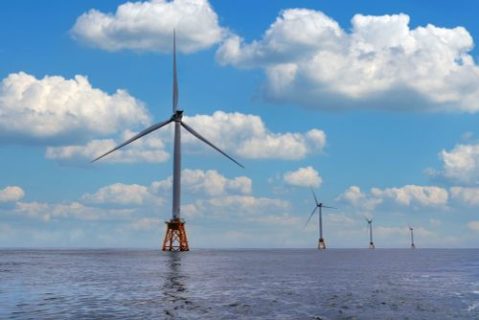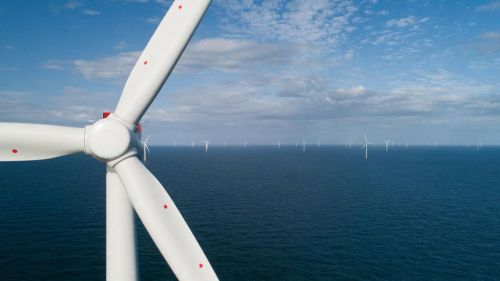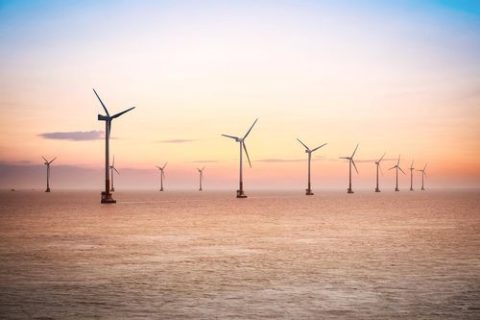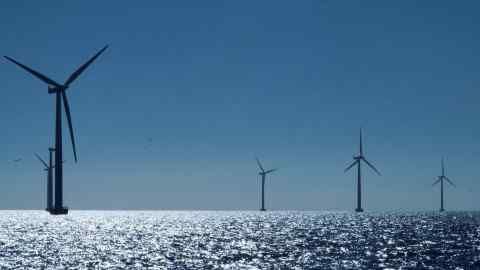After a year, in the industry that raised doubts about the future of New England’s Offshore Energy , Massachusetts and its neighboring states unveiled their options for advancing clean energy on Wednesday.
Massachusetts is aiming to secure up to 3,600 megawatts of New England’s Offshore Energy in its procurement round. Collaborating with Rhode Island and Connecticut through a state partnership these states are aligning their choices to collectively acquire 6,000 MW of New England’s Offshore Energy capacity. While the total bids fell short of the 6,000 MW target there’s potential for state projects to emerge.
Challenges
The recent bidding process follows a period where Northeastern states, including Massachusetts faced setbacks in offshore wind development. Inflation and disruptions caused by the conflict in Ukraine led to increased costs for projects selected in Massachusetts previous procurement rounds. Developers had to pay fines to withdraw from agreed contracts. The re bidding of these projects on Wednesday is anticipated to result in costs, for consumers.
By the deadline of Wednesday at noon Massachusetts received proposals from three developers who also submitted their plans for the state solicitation; Vineyard Offshore, Avangrid Renewables and SouthCoast Wind. In total the projects offered to Massachusetts on Wednesday could potentially generate a combined 4,270 MW of power. Additionally developer Orsted proposed a 1,184 MW project, for Rhode Island and Connecticut bringing the capacity for the multi state initiative to around 5,454 MW.

“The Healey Driscoll Administration will carefully assess the bids in the months and collaborate with Connecticut and Rhode Island to evaluate state projects that can maximize benefits for the region reduce costs and improve project sustainability ” stated Elizabeth Mahony, Commissioner of the Department of Energy Resources. “Massachusetts is dedicated to expanding its wind sector as part of our transition to clean energy. This effort will drive our shift towards energy sources that’re both environmentally friendly and cost effective for households and businesses. We are enthusiastic about progressing through this process.”
The bids submitted on Wednesday offer insight into the status of the New England’s Offshore Energy and efforts in the region to move away from reliance on fuels. However they also highlight that there is still a journey, in this transition process.
Three companies that submitted proposals to Massachusetts indicated that their projects could commence delivering power in 2029 (Avangrid) 2030 (SouthCoast Wind) and 2031 (Vineyard Offshore)—a time frame ranging from five to seven years, from now.
Another significant query revolves around the cost escalation compared to the selected (and subsequently scrapped) projects. This question will remain unanswered until one or more projects are chosen for contract discussions in August. While the companies have provided pricing data they retain the right to redact specifics regarding pricing and project details from the public versions of their bid documents.
“The unveiling of todays state offshore wind proposals marks a significant achievement in transitioning the Northeast away from fossil fuels towards clean renewable energy. The development of wind is essential for establishing an economy on clean electricity to power our vehicles, homes, businesses and industries. A future devoid of wind means a lack of progress towards an electric era ” remarked Kate Sinding Daly, senior vice president of law and policy at the Conservation Law Foundation. “To combat climate change enhance our well being purify our air and water—ambitious offshore wind initiatives, like those envisioned for Massachusetts, Rhode Island and Connecticut must materialize.”The bids will be reviewed by a team led by DOER, which includes the utilities to purchase energy (National Grid, Eversource and Unitil) the Executive Office of Economic Development and input, from an independent consulting firm. The states request for proposals outlines the criteria for evaluation; analyzing the projects costs and its impacts on the energy market quantitatively and assessing economic development potential, environmental impact fisheries impact and support for low income ratepayers qualitatively.
Massachusetts projects or a project will be chosen for contract discussions by Aug. 7. The long term contracts should be finalized by Oct. 9. Submitted for approval by the Department of Public Utilities by Nov. 13.
The three states have the flexibility to fulfill their procurement needs with either a state project or a combination of single state and multi state projects within their capacity limits as per the MOU agreement. Any two states can jointly select a state offshore wind proposal that meets their maximum procurement capacity allowing for possibilities, like a Massachusetts Connecticut wind venture or a Rhode Island Connecticut wind endeavor that would provide clean energy to all three states.
Vineyard Wind 2
The company Vineyard Offshore which was involved in the Vineyard Wind 1 project recently revealed plans, for a project called Vineyard Wind 2. This project aims to generate 1,200 MW of power. Is projected to commence operations in 2031. The proposal was submitted to Massachusetts, Rhode Island and Connecticut separately as collectively through a joint solicitation process.
The proposed Vineyard Wind 2 project is planned to be located 29 miles of Nantucket adjacent to the existing Vineyard Wind 1 project. The offshore construction staging site will be in Salem with steel components sourced from a Providence based company. The power generated will be connected to the New England grid in Montville, Conn. And operational activities will be based out of New Bedford. The goal is to provide electricity for over 650,000 households.
According to the companys submission Vineyard Wind 2 focuses on ensuring deliverability by managing supply chain risks optimizing tax incentives utilizing a reliable delivery point and making use of the port infrastructure, in New England.
“With Vineyard Wind 2s construction activities, operations and maintenance centered in Massachusetts, secondary steel fabrication, in Rhode Island and a delivery point in Connecticut the project offers the region a configuration that aligns with the Commonwealths goal of becoming a player in offshore wind globally.
If chosen Vineyard Offshore stated that its project would reduce 2.1 million tons of carbon dioxide emissions annually in New England equivalent to removing 414,000 cars from the roads. Officials mentioned that Vineyard Wind 2 is expected to result in $2.3 billion in expenses and provide 3,800 job years of employment throughout New England with over $1.5 billion spent and 80% of jobs created within Massachusetts.
Similar to developers participating in the bidding process Vineyard Offshore did not reveal the pricing details for the power generated by its Vineyard Wind 2 project. The company highlighted benefits such as electricity market impacts worth up to $4.8 billion over two decades by adding 1,200 MW of wind to the New England’s Offshore Energy . This includes $600 million, from electricity prices and avoidance of winter price fluctuations.”Support, for the Vineyard Offshore proposal was expressed by Representatives Christopher Hendricks from New Bedford and Christopher Markey from Dartmouth as Salem Mayor Dominick Pangallo, eight city councilors from New Bedford and the mayors of New London and Montville, Connecticut.
Avangrid, a player in the energy industry presented proposals under the banner of New England’s Offshore Energy. This initiative comprises two projects. A 791 MW New England Wind 1 project and a 1,080 MW New England Wind 2 project. The company disclosed that it submitted bids spanning three states for New England Wind 1 another bid for both New England Wind 1 and 2 combined across three states and additional bids for state procurements in Massachusetts, Connecticut and Rhode Island.
Avangrid, known for its involvement in the Vineyard Wind 1 project described its New England’s Offshore Energy ventures as “some of the most advanced offshore wind opportunities, in the country ” with potential to start commercial operations before the decade ends. These projects aim to provide a solution addressing energy needs, climate concerns and economic growth in the region.
The rebranding of the Commonwealth Wind project, as the New England Wind 2 label occurred after its cancellation in August accompanied by Avangrid paying $48 million in penalties. The developer cited inability to finance the project at the agreed upon price as the reason for cancellation. This project is now part of the combined New England Wind 1 and 2 venture. Was not presented as an initiative.
Regarding infrastructure costs if the first project does not proceed and is not awarded these costs would be transferred to the project along with expenses. The aim is to ensure that each project bears its required expenses without burdening others. Avangrids chief development officer for wind Ken Kimmel emphasized this point by stating that cost allocation should be done in a way that supports each project independently.
Avangrids CEO Pedro Azagra highlighted that priority is given to advancing the New England Wind 1 project due to its progress, in permitting procedures and potential earlier completion date before the decade ends.
The Bureau of Ocean Energy Management released an environmental impact statement, for the project in February. They are anticipated to make a decision by April and approve the projects construction and operations plan by July.
“We are at a moment for climate action and New England’s Offshore Energy steps up to meet the regions need for projects that embody the urgency, ambition and certainty required at this time ” stated an official. “By launching Vineyard Wind 1 Avangrid demonstrated that American offshore wind power is feasible. New England Wind 1 continues this progress with a to go project set to commence construction early as next year. With all permits secured at state and federal levels interconnection rights confirmed and a Project Labor Agreement in place, with skilled local union workers Avangrid is fully prepared.”

Described as an ready to implement initiative previously named Park City Wind, the New England Wind 1 project was highlighted by Avangrid. The company concluded its contracts related to Park City Wind year by paying Connecticut a penalty.
The proposed site is set to be situated in a lease area, below the Vineyard Wind 1 project. Avangrid intends to contribute $30 million upfront and $100 million in lease payments to support the development of the marshaling port in Salem.
“This port has the potential to positively impact our North Shore region. It needs to be put into operation. Being the confirmed tenant at the Salem Port Avangrid is well positioned to bring about a project for Massachusetts that can assist in meeting its crucial energy requirements and creating new economic prospects for residents here on the North Shore ” stated Sen. Joan Lovely and Rep. Manny Cruz of Salem as cited by Avangrid.
According to Avangrid the initiative could supply electricity for around 400,000 homes. Cut emissions to removing 300,000 gasoline powered cars from the streets annually. The project is estimated to generate over 4,400 full time jobs and drive $3 billion, in investments into the area.
“New England Wind 1 presents reliability and feasibility.”The company mentioned in its announcement that with all the state, regional and local permits secured, along, with a host community agreement with the Town of Barnstable and federal permits in place construction on the project could commence as early as next year to meet the 2029 commercial operations target. This initiative aims to support the 2030 state climate goals set by the New England states.
As part of the project proposal there is a plan to supply power from one turbine (15 MW) to Boston. Avangrid stated that this would be adequate to power one third of all buildings in Boston Public Schools (BPS) along with around 5,000 homes.
Capacity
The combined New England Wind 1 and 2 project is expected to generate 1,870 MW for New England sufficient to provide electricity for a million homes and reduce emissions by an amount to removing about 700,000 cars from the roads on an annual basis. Avangrid estimated that this joint effort could create up to 9,200 full time jobs and bring $8 billion in investment into New England.

Additionally within this endeavor is a plan to utilize the subsea export cables manufactured at Prysmian Cable Manufacturings facility being established by Italian company Prysmian in Somerset. However Avangrid noted that this facility might not be operational in time, for New England Wind 1.
Overcoming challenges
The proposal, for the SouthCoast Wind project, owned by OW Ocean Winds was submitted across three states for a 1,200 MW initiative. This mirrors the SouthCoast Wind project that got canceled year—a combination of an 800 MW project chosen in 2019 and a 400 MW project picked in 2021.
“The significant inflation experienced during 2020 2023 had an impact on infrastructure costs disrupting the aspects of projects with fixed revenues yet flexible costs. Losing feasibility for our awarded projects at SouthCoast was challenging. Not due to their importance to Massachusetts and New England but also because those awards were a source of pride for our team ” stated the company in its bid. “The key takeaway is that a swift shift from award to construction is crucial to mitigating risks in a setting. Acknowledging this necessity SouthCoast dedicated the 18 months ensuring that the Project is prepared for construction post award.”
The bid document, from SouthCoast Wind describes it as a ” project set to commence construction in 2025 ” offering “measurable project advantages that significantly surpass contractual expenses.
SouthCoast Winds CEO, Michael Brown stated that the project is progressing as planned to provide sustainable energy to New Englands power grid by 2030.
Read also Top 10 largest offshore wind farms in the USA
Read also Construction begins on Coastal Virginia Offshore Wind project by dominion.

